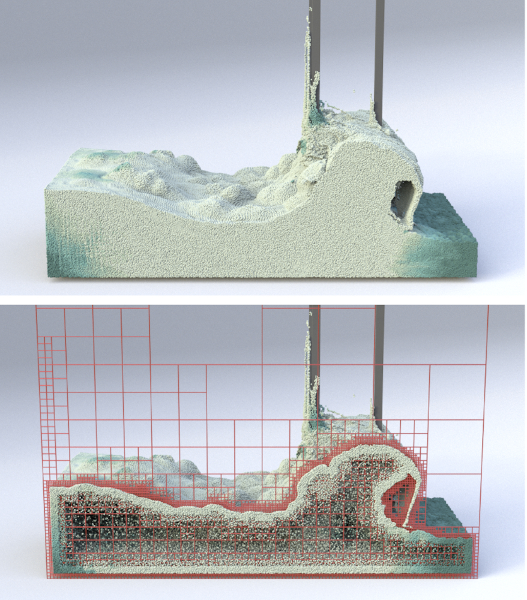
RBF liquids: an adaptive PIC solver using RBF-FD
R. Nakanishi, F. Nascimento, R. Campos, P. Pagliosa, and A. Paiva
ACM Transactions on Graphics (SIGGRAPH Asia 2020), 2020, 39(6)
Abstract We introduce a novel liquid simulation approach that combines a spatially adaptive pressure projection solver with the Particle-in-Cell (PIC) method. The solver relies on a generalized version of the Finite Difference (FD) method to approximate the pressure field and its gradients in tree-based grid discretizations, possibly non-graded. In our approach, FD stencils are computed by using meshfree interpolations provided by a variant of Radial Basis Function (RBF), known as RBF-Finite-Difference (RBF-FD). This meshfree version of the FD produces differentiation weights on scattered nodes with high-order accuracy. Our method adapts a quadtree/octree dynamically in a narrow-band around the liquid interface, providing an adaptive particle sampling for the PIC advection step. Furthermore, RBF affords an accurate scheme for velocity transfer between the grid and particles, keeping the system’s stability and avoiding numerical dissipation. We also present a data structure that connects the spatial subdivision of a quadtree/octree with the topology of its corresponding dual-graph. Our data structure makes the setup of stencils straightforward, allowing its updating without the need to rebuild it from scratch at each time-step. We show the effectiveness and accuracy of our solver by simulating incompressible inviscid fluids and comparing results with regular PIC-based solvers available in the literature.
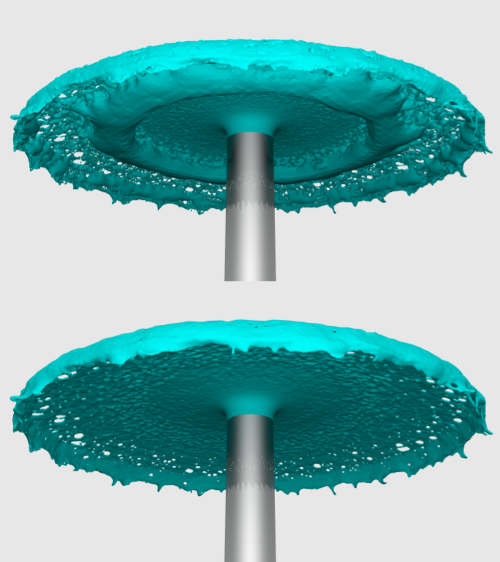
Boundary particle resampling for surface reconstruction in liquid animation
M. Sandim, N. Oe, D. Cedrim, P. Pagliosa, and A. Paiva
Computer and Graphics, 2019, 84, 55-6
Abstract In this paper, we present a novel adaptive particle resampling method tailored for surface reconstruction of level-sets defined by the boundary particles from a particle-based liquid simulation. The proposed approach is simple and easy to implement, and only requires the positions of the particles to identify and refine regions with small and thin fluid features accurately. The method comprises four main stages: boundary detection, feature classification, particle refinement, and surface reconstruction. For each simulation frame, firstly the free-surface particles are captured through a boundary detection method. Then, the boundary particles are classified and labeled according to the deformation and the stretching of the free-surface computed from the Principal Component Analysis (PCA) of the particle positions. The particles placed at feature regions are then refined according to their feature classification. Finally, we extract the free-surface of the zero level-set defined by the resampled boundary particles and its normals. In order to render the free-surface, we demonstrate how the traditional methods of surface fitting in Computer Graphics and Computational Physics literature can benefit from the proposed resampling method. Furthermore, the results shown in the paper attest the effectiveness and robustness of our method when compared to state-of-the-art adaptive particle resampling techniques.
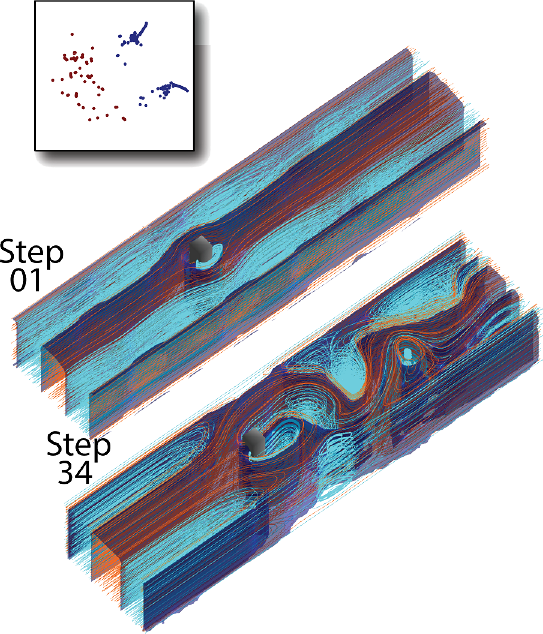
A user-friendly interactive framework for unsteady fluid flow segmentation and visualization
D. Motta, W. Casaca, P. Pagliosa, and A. Paiva
Journal of Visualization, 2018, 21(4), 625-636
Abstract While vector fields are essential to simulate a great amount of natural phenomena, the difficulty to identify patterns and predict behaviors makes the visual segmentation in simulations an attractive and powerful tool. In this paper, we present a novel user-steered segmentation framework to cope with steady as well as unsteady vector fields on fluid flow simulations. Given a discrete vector field, our approach extracts multi-valued features from the field by exploiting its streamline structures so that these features are mapped to a visual space through a multidimensional projection technique. From an easy-to-handle interface, the user can interact with the projected data so as to partition and explore the most relevant vector features in a guidance frame of the simulation. Besides navigating and visually mining structures of interest, the interactivity with the projected data also allows us to progressively enhance the segmentation result according to the user insights. Finally, to successfully deal with unsteady simulations, the segments previously annotated by the user are used as a training set for a Support Vector Machine (SVM) approach that classifies the remaining frames in the flow. We attest the effectiveness and versatility of our methodology throughout a set of classical physical-inspired applications on fluid flow simulations as depicted in the experiment results section.
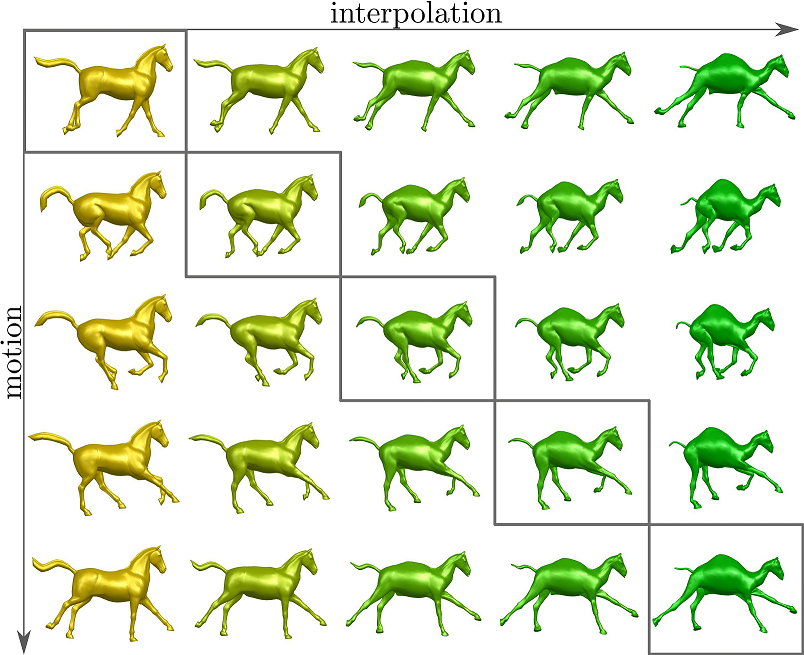

Least-squares Morphing of Dynamic Meshes
A. Medalha, L. Pagliosa, A. Paiva, and P. Pagliosa
Proceedings of SIBGRAPI 2017, IEEE Press, 2017, 23-30
doi bibtex mp4 BEST PAPER in Computer Graphics/Visulization (Main Track)
Abstract Morphing is a technique that smoothly transforms a shape onto another. In this paper, we present a method for morphing of two dynamic meshes: mesh sequences representing the keyframes of animated shapes over time. The pipeline of the proposed method comprises two main stages: template-based cross-parameterization and dynamic mesh interpolation. In the cross-parameterization stage, we use a variation of least-squares (LS) meshes to provide a coarse approximation of the geometry of the source mesh onto the target mesh. In our method, the possible candidates for initial control points of the LS-mesh are detected using an approach based on the Heat Kernel Signature (HKS). Then, an iterative process of fine fitting adds new constraints in the LS-mesh processing. The cross-parameterization is performed just once for any two frames in order to establish a full correspondence between vertices of the source and target meshes. Next, we use such a correspondence in the dynamic mesh interpolation stage to produce the morphing results. The method is entirely mesh-based and does not demand the generation of skeletons, mesh segmentation or the use of any additional control structures. Moreover, it does not require the two input meshes to share the same number of vertices or triangles, or to have the same connectivity. The provided results show the robustness and effectiveness of our method.
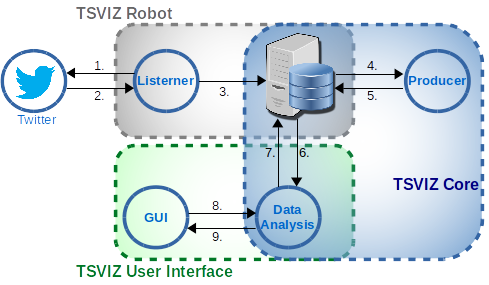
TSViz: A Data Stream Architecture to Online Collect, Analyze, and Visualize Tweets
R. Rios, R. Ishii, P. Pagliosa, and R. Mello
Proceedings of ACM SAC 2017, ACM, 2017, 1031-1036
Abstract The huge amount of data daily produced through social networks, such as Twitter, has been motivating several researchers and companies to design approaches to model and study users' behavior/feelings. Most of the current studies have been focusing on building tweet datasets which are later analyzed using offline tools. This paper introduces a new approach through the development of the TSViz tool which online collects and analyzes tweets seen as data streams (in an online and incremental fashion). Given a hashtag, TSViz online gathers all tweets associated to it and organizes a multidimensional data stream, which can be seen as a time series. TSViz has three main components: i) a Robot responsible for the online collection of tweets according to the selected hashtags (defined by users); ii) an analysis component which employs Statistics, Dynamical Systems and Machine Learning methods to extract information and patterns from data; iii) a Web visualization tool to support users' interpretation of results. In the context of this paper, we present results on hashtags associated with the Brazil's political crisis in an attempt to understand the impacts of the public opinion and their relationships to the impeachment of its president. Our analysis confirms the daily volume of tweets and the amount of new information suffered a significant impact along time due to specific events associated with the impeachment process.
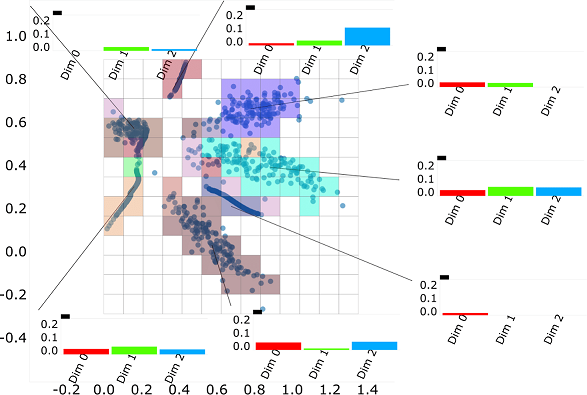
Understanding Attribute Variability in Multidimensional Projections
L. Pagliosa, P. Pagliosa, and L.G. Nonato
Proceedings of SIBGRAPI 2016, IEEE Press, 2016, 297-304
doi bibtex mp4 HONORABLE MENTION
Abstract Multidimensional Projection techniques can help users to find patterns in multidimensional data. However, while the visualization literature is rich in techniques designed to improve the projection itself, only a handful of papers shed light into the attributes that contribute to cluster formation or the spread of projected data. In this paper, we present a web-based visualization tool that enriches multidimensional projection layout with statistical measures derived from inputted data. Given a set of regions to analyze, we used statistical measures, such as variance, to highlight relevant attributes that contribute to the points' similarities in each region. Experimental tests show that our technique can help identify important attributes and explain projected data.
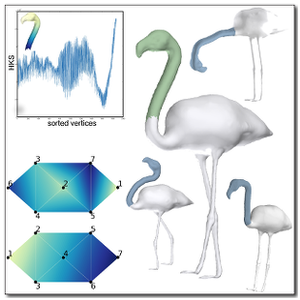
Partial Similarity of 3D Shapes Using Cross Recurrence Plot
R.U. Nakanishi, J.P. Ono, P. Pagliosa, L.G. Nonato, and A. Paiva
Proceedings of SIBGRAPI 2016, IEEE Press, 2016, 448-454
Abstract This paper presents a novel 3D partial shape retrieval algorithm based on time-series analysis. Given a piece of a 3D shape, the proposed method encodes the shape descriptor given by the Heat Kernel Signature (HKS) as a time-series, where the time is considered an ordered sequence of vertices provided by the Fiedler vector. Finally, a similarity metric is created using a well-known tool in time-series analysis called Cross Recurrence Plot (CRP). The good performance of our method is also attested in a large collection of shape models.
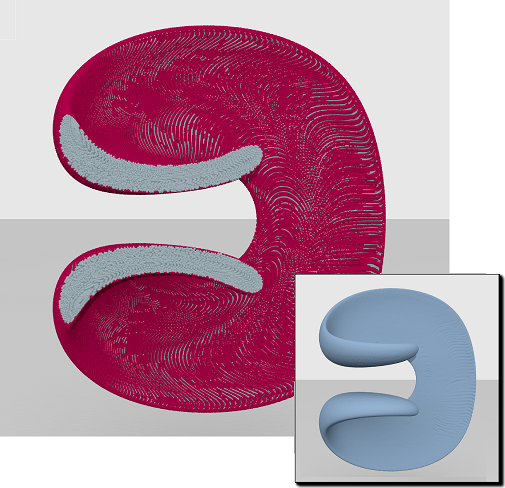
Boundary Detection in Particle-based Fluids
M. Sandim, D. Cedrim, L.G. Nonato, P. Pagliosa, and A. Paiva
Computers Graphics Forum, 2016, 35(2), 215-224
Abstract This paper presents a novel method to detect free-surfaces on particle-based volume representation. In contrast to most particle-based free-surface detection methods, which perform the surface identification based on physical and geometrical properties derived from the underlying fluid flow simulation, the proposed approach only demands the spatial location of the particles to properly recognize surface particles, avoiding even the use of kernels. Boundary particles are identified through a Hidden Point Removal (HPR) operator used for visibility test. Our method is very simple, fast, easy to implement and robust to changes in the distribution of particles, even when facing large deformation of the free-surface. A set of comparisons against state-of-the-art boundary detection methods show the effectiveness of our approach. The good performance of our method is also attested in the context of fluid flow simulation involving free-surface, mainly when using level-sets for rendering purposes.
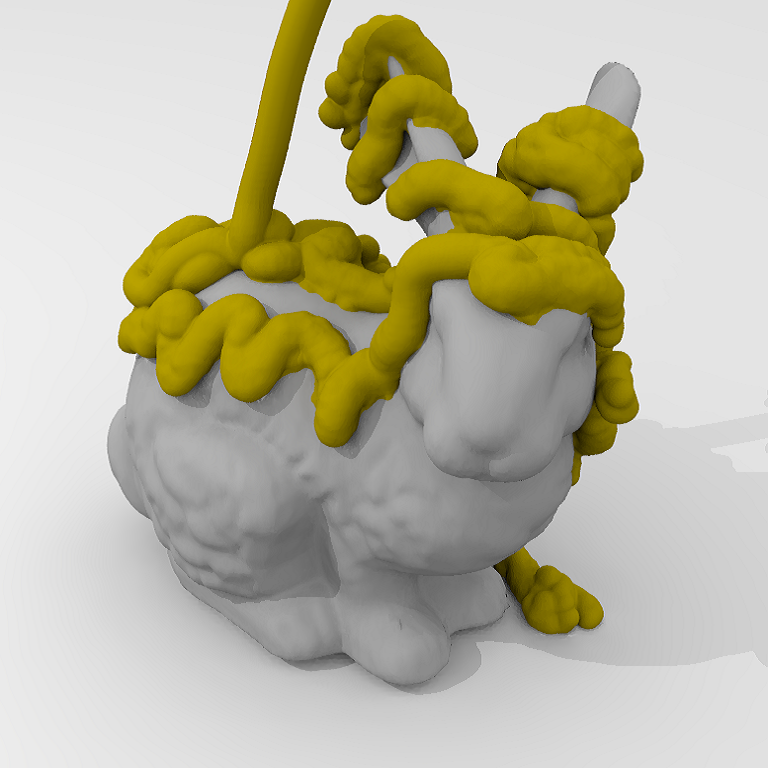
Particle-based fluids for viscous jet buckling
L.F.S. Andrade, M. Sandim, F. Petronetto, P. Pagliosa, and A. Paiva
Computers & Graphics, 2015, 52, 106-115
Abstract In this paper, we introduce a novel meshfree framework for animating free surface viscous liquids with jet buckling effects, such as coiling and folding. Our method is based on Smoothed Particle Hydrodynamics (SPH) fluids and allows more realistic and complex viscous behaviors than the previous SPH frameworks in computer animation literature. The viscous liquid is modeled by a non-Newtonian fluid flow and the variable viscosity under shear stress is achieved using a viscosity model known as Cross model. We demonstrate the efficiency and stability of our framework in a wide variety of animations, including scenarios with arbitrary geometries and high resolution of SPH particles. The interaction of the viscous liquid with complex solid obstacles is performed using boundary particles. Our framework is able to deal with different inlet velocity profiles and geometries of the injector, as well as moving inlet jet along trajectories given by cubic Hermite splines. Moreover, the simulation speed is significantly accelerated by using Computer Unified Device Architecture (CUDA) computing platform.
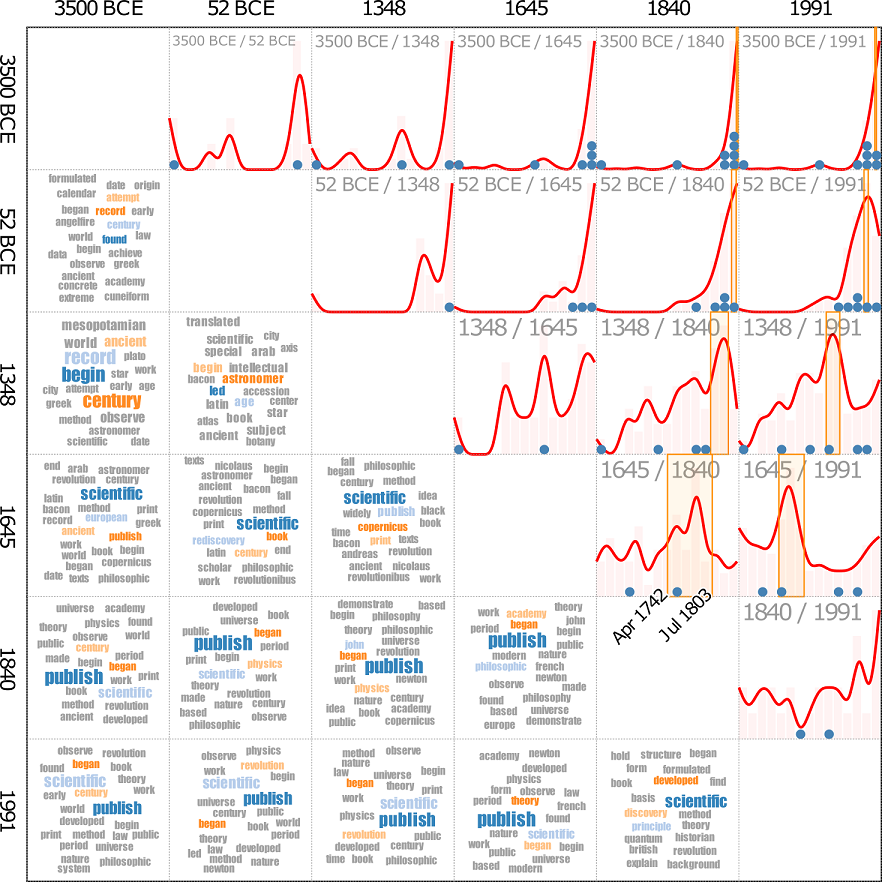
Linea: Building Timelines from Unstructured Text
T. Etiene, P. Pagliosa, and L.G. Nonato
Proceedings of SIBGRAPI 2015, IEEE Press, 2015, 234-241
Abstract Timelines are often used for summarizing complex, time-evolving, sequences of events. In this work, we propose Linea, a tool that helps users build timelines from unstructured text. Besides providing interactive tools for browsing, selecting, editing, and filtering events, Linea includes mechanisms to build smart defaults, thus providing good starting points for users to create their own timelines. The core component is a novel visualization widget called event matrix, a matrix designed to explore events over time and in different time scales. We illustrate the strengths of our tool with a case study showing that important events can be browsed, timelines can be easily built, and show the result of an information user evaluation.
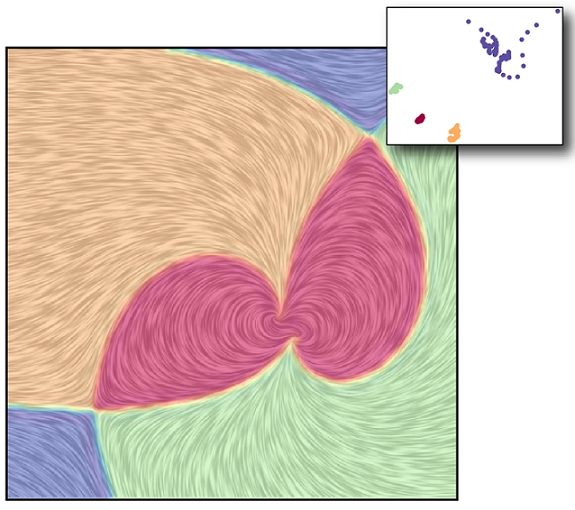
Exploratory Segmentation of Vector Fields Using Multidimensional Projection
D. Motta, M. Oliveira, P. Pagliosa, L.G. Nonato, and A. Paiva
Proceedings of SIBGRAPI 2015, IEEE Press, 2015, 250-256
Abstract The difficulty to understand the complex behavior of vector fields makes its visual segmentation an area of constant interest in scientific visualization. In this paper, we present a novel interactive segmentation framework for discrete vector fields. In our method, the vector field domain is partitioned into multiple regions with same flow patterns. In order to accomplish this task, feature vectors are extracted from streamlines and mapped to a visual space using multidimensional projection. The interactivity with projected data in the visual space improving the results of the segmentation according to user’s knowledge. The provided results and comparisons show the flexibility and effectiveness of our framework.
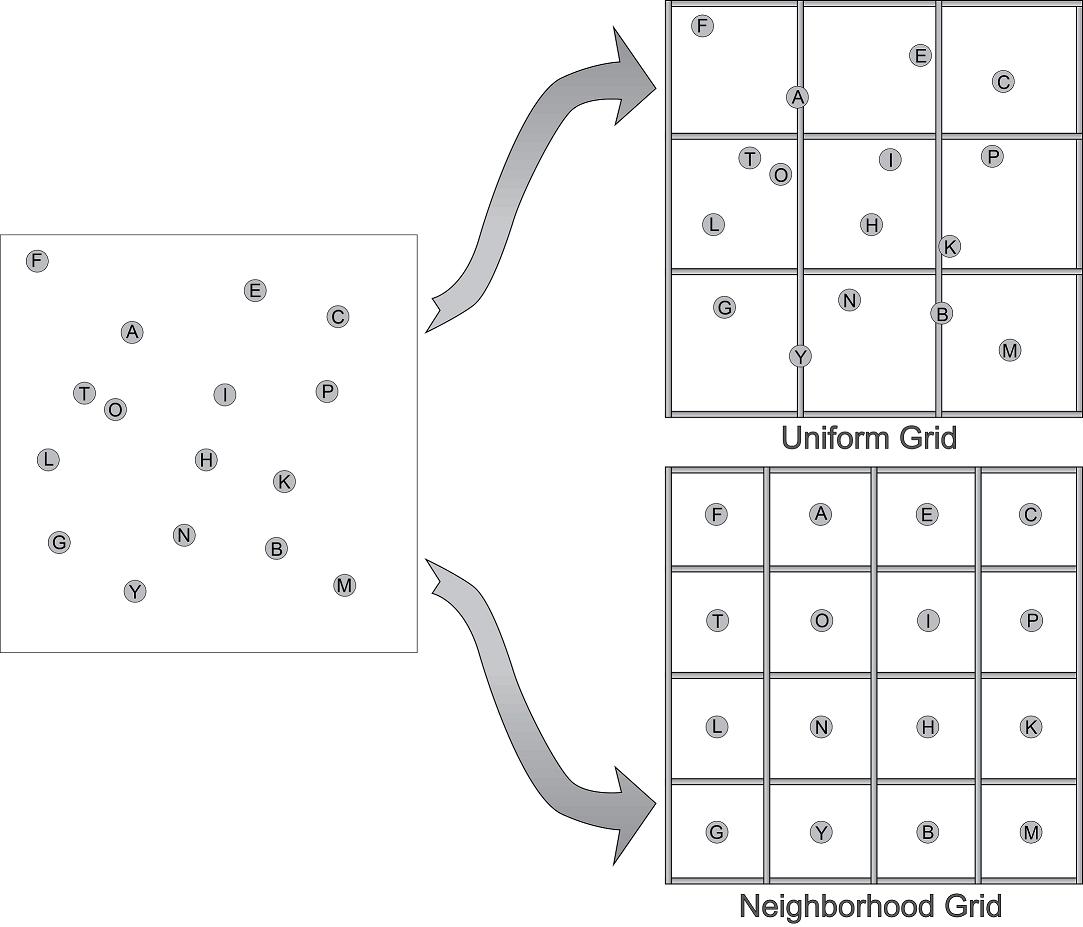
Neighborhood grid: A novel data structure for fluids animation with GPU computing
M. Joselli, J.R. Silva Junior, E.W.G. Clua, A. Montenegro, M. Lage, and P. Pagliosa
Journal of Parallel and Distributed Computing, 2015, 75, 20-28
Abstract This paper introduces a novel and efficient data structure, called neighborhood grid, capable of supporting large number of particle based elements on GPUs (graphics processing units), and is used for optimizing fluid animation with the use of GPU computing. The presented fluid simulation approach is based on SPH (smoothed particle hydrodynamics) and uses a unique algorithm for the neighborhood gathering. The brute force approach to neighborhood gathering of n particles has complexity O(n^2), since it involves proximity queries of all pairs of fluid particles in order to compute the relevant mutual interactions. Usually, the algorithm is optimized by using spatial data structures which subdivide the environment in cells and then classify the particles among the cells based on their position, which is not efficient when a large number of particles are grouped in the same cell. Instead of using such approach, this work presents a novel and efficient data structure that maintains the particles into another form of proximity data structure, called neighborhood grid. In this structure, each cell contains only one particle and does not directly represent a discrete spatial subdivision. The neighborhood grid does process an approximate spatial neighborhood of the particles, yielding promising results for real time fluid animation, with results that goes up to 9 times speedup, when compared to traditional GPU approaches, and up to 100 times when compared against CPU implementations.
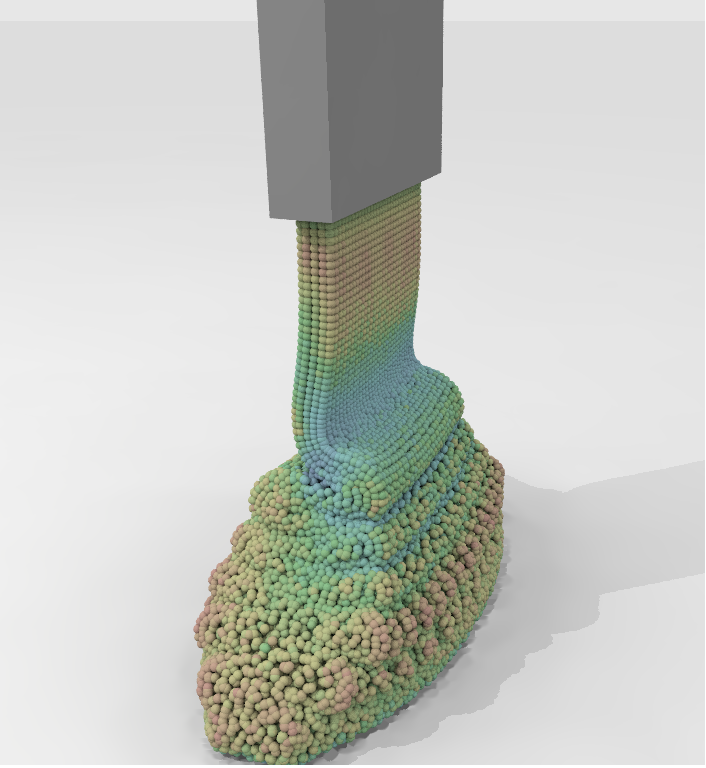
SPH Fluids for Viscous Jet Buckling
L.F.S. Andrade, M. Sandim, F. Petronetto, P. Pagliosa, and A. Paiva
Proceedings of SIBGRAPI 2014, IEEE Press, 2014, 65-72
doi bibtex mp4 BEST PAPER in Computer Graphics
Abstract We present a novel meshfree technique for animating free surface viscous liquids with jet buckling effects, such as coiling and folding. Our technique is based on Smoothed Particle Hydrodynamics (SPH) fluids and allows more realistic and complex viscous behaviors than the preceding SPH frameworks in computer animation literature. The viscous liquid is modeled by a non-Newtonian fluid flow and the variable viscosity under shear stress is achieved using a viscosity model known as Cross model. The proposed technique is efficient and stable, and our framework can animate scenarios with high resolution of SPH particles in which the simulation speed is significantly accelerated by using Computer Unified Device Architecture (CUDA) computing platform. This work also includes several examples that demonstrate the ability of our technique.
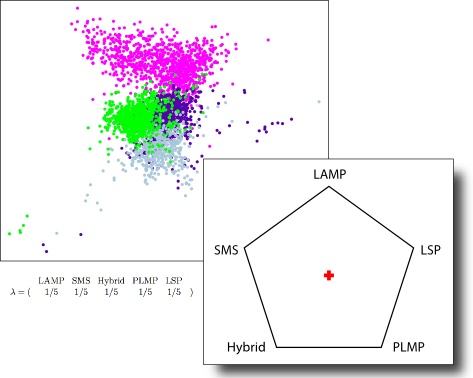
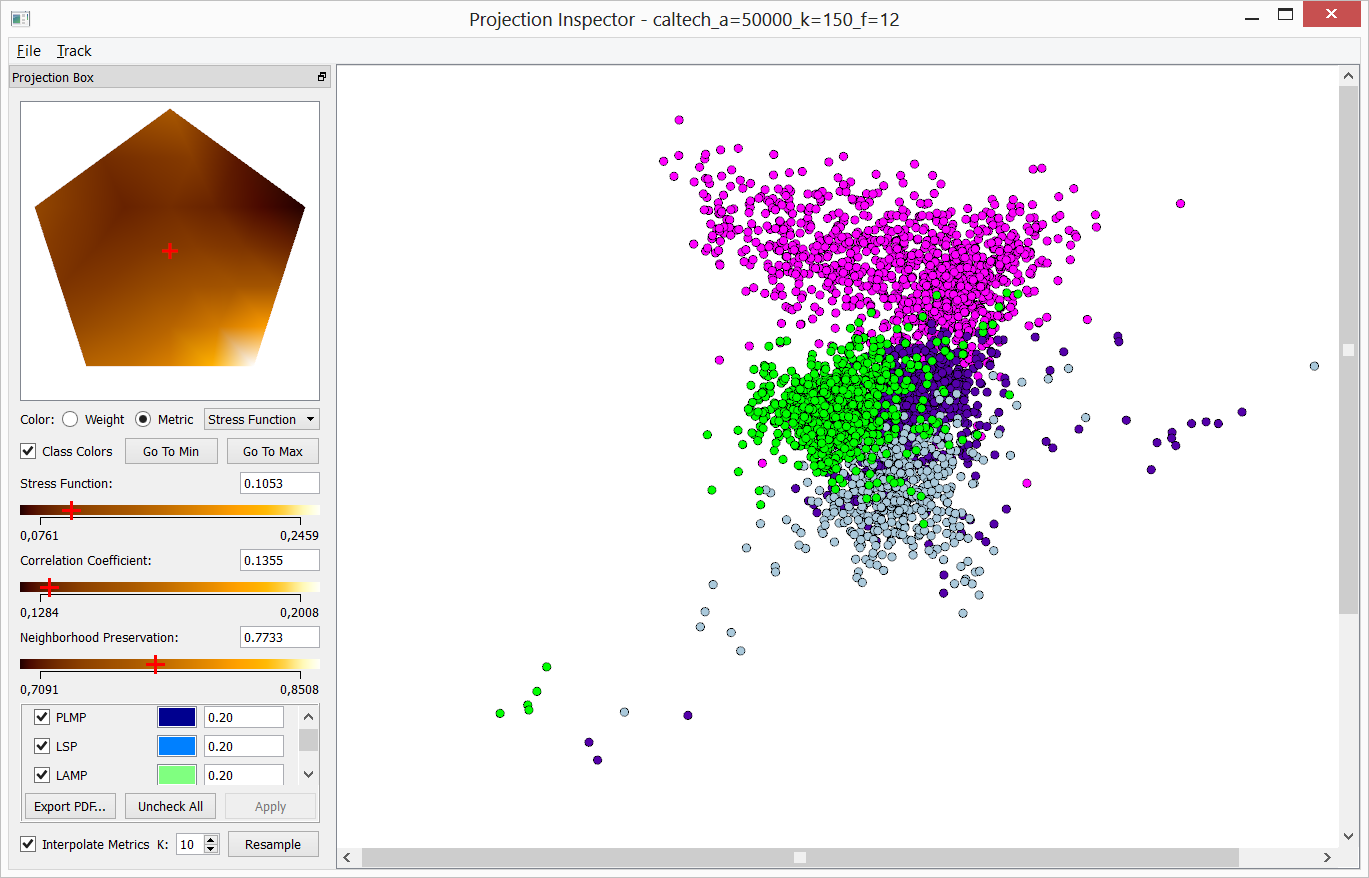
Projection Inspector: Assessment and synthesis of multidimensional projections
P. Pagliosa, F.V. Paulovich, R. Minghim, H. Levkowitz, and L.G. Nonato
Neurocomputing, 2015, 150, Part B, 599-610
Abstract As the number and complexity of visualization techniques have grown, it has become progressively more difficult to make a decision as to which technique to employ for any given situation or application. A particular case is that of multidimensional data visualization utilizing projections, which have gained much attention lately and are being utilized in a growing number of applications. With their popularity, many new variations of multidimensional projections have been proposed in the literature. Numerical evaluations are varied and are useful, but do not reflect visual properties of projections accurately. In this paper we present Projection Inspector, an approach that contributes to the problem of understanding the difference amongst projections. It is an interactive assessment method that allows a user to explore a "space" of known projection techniques and view their results, as well as to identify the differences between them. In addition, it generates "on-the-fly" new projection techniques via interpolations of existing techniques as the user explores the projection space. We present the theoretical foundations of the projection exploration space and an interactive tool that implements a view of this space. We demonstrate the approach with case studies that demonstrate the need for projection assessment and the value of combining projections into new, better suited, projection alternatives.
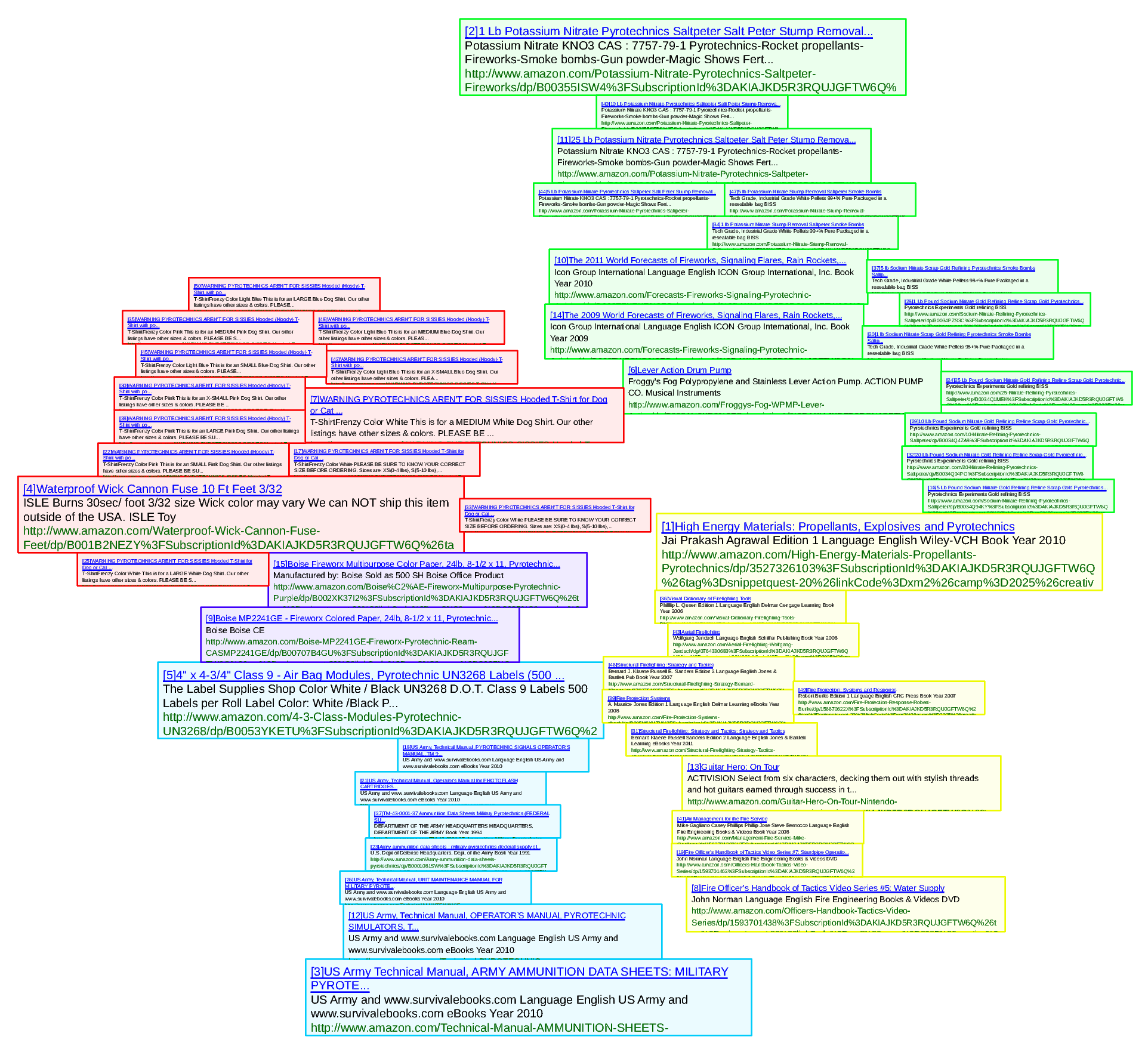
Similarity Preserving Snippet-Based Visualization of Web Search Results
E. Gomez-Nieto, F. San Roman, P. Pagliosa, W. Casaca, E.S. Helou, M.C.F. Oliveira, and L.G. Nonato
IEEE Transactions on Visualization and Computer Graphics, 2014, 20(3), 457-470
Abstract Internet users are very familiar with the results of a search query displayed as a ranked list of snippets. Each textual snippet shows a content summary of the referred document (or web page) and a link to it. This display has many advantages, e.g., it affords easy navigation and is straightforward to interpret. Nonetheless, any user of search engines could possibly report some experience of disappointment with this metaphor. Indeed, it has limitations in particular situations, as it fails to provide an overview of the document collection retrieved. Moreover, depending on the nature of the query — e.g., it may be too general, or ambiguous, or ill expressed — the desired information may be poorly ranked, or results may contemplate varied topics. Several search tasks would be easier if users were shown an overview of the returned documents, organized so as to reflect how related they are, content-wise. We propose a visualization technique to display the results of web queries aimed at overcoming such limitations. It combines the neighborhood preservation capability of multidimensional projections with the familiar snippet-based representation by employing a multidimensional projection to derive two-dimensional layouts of the query search results that preserve text similarity relations, or neighborhoods. Similarity is computed by applying the cosine similarity over a "bag-of-words" vector representation of collection built from the snippets. If the snippets are displayed directly according to the derived layout they will overlap considerably, producing a poor visualization. We overcome this problem by defining an energy functional that considers both the overlapping amongst snippets and the preservation of the neighborhood structure as given in the projected layout. Minimizing this energy functional provides a neighborhood preserving two-dimensional arrangement of the textual snippets with minimum overlap. The resulting visualization conveys both a global view of the query results and visual groupings that reflect related results, as illustrated in several examples shown.
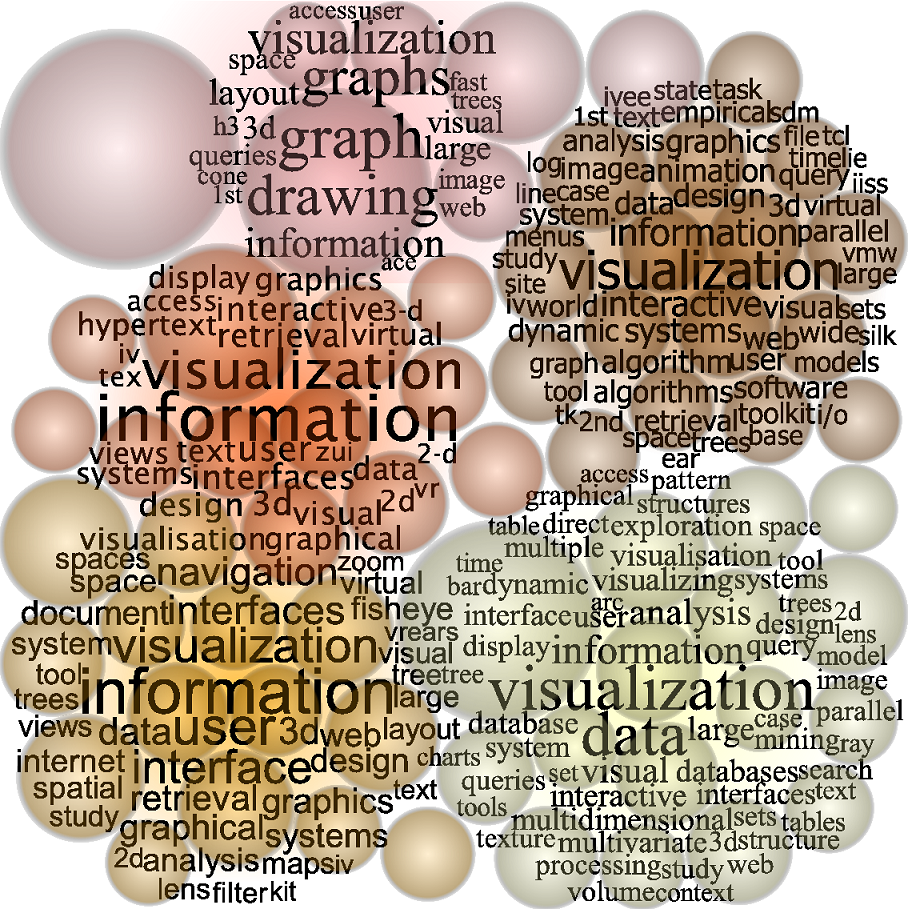
MIST: Multiscale Information and Summaries of Texts
P. Pagliosa, R.M. Martins, D. Cedrim, A. Paiva, R. Minghim, and L.G. Nonato
Proceedings of SIBGRAPI 2013, IEEE Press, 2013, 91-98
Abstract Combining distinct visual metaphors has been the mechanism adopted by several systems to enable the simultaneous visualization of multiple levels of information in a single layout. However, providing a meaningful layout while avoiding visual clutter is still a challenge. In this work we combine word clouds and a rigid-body simulation engine into an intuitive visualization tool that allows a user to visualize and interact with the content of document collections using a single overlap-free layout. The proposed force scheme ensures that neighboring documents are kept close to each other during and after layout change. Each group of neighboring documents formed on the layout generates a word cloud. A multi-seeded procedure guarantees a harmonious arrangement of distinct word clouds in visual space. The visual metaphor employs lenses to represent document instances where the size of each lens defines the importance of the document in the collection. To keep the visualization clean and intuitive, only the most relevant documents are depicted as lens while the remaining ones are either displayed as smaller glyphs to help convey density information or simply removed from the layout. Hidden instances are moved together with its neighbors during force-based simulation, should they become visible later, but are not processed individually. This shadow movement avoids excess calculations by the force-based scheme, thus ensuring scalability and interactivity.

A heterogeneous system based on GPU and multi-core CPU for real-time fluid and rigid body simulation
J.R. Silva Junior, E.W.G. Clua, A. Montenegro, M. Lage, M.A. Dreux, M. Joselli, P. Pagliosa, and C.L. Kuryla
International Journal of Computational Fluid Dynamics, 2012, 26(3), 193-204
Abstract Computational fluid dynamics in simulation has become an important field not only for physics and engineering areas but also for simulation, computer graphics, virtual reality and even video game development. Many efficient models have been developed over the years, but when many contact interactions must be processed, most models present difficulties or cannot achieve real-time results when executed. The advent of parallel computing has enabled the development of many strategies for accelerating the simulations. Our work proposes a new system which uses some successful algorithms already proposed, as well as a data structure organisation based on a heterogeneous architecture using CPUs and GPUs, in order to process the simulation of the interaction of fluids and rigid bodies. This successfully results in a two-way interaction between them and their surrounding objects. As far as we know, this is the first work that presents a computational collaborative environment which makes use of two different paradigms of hardware architecture for this specific kind of problem. Since our method achieves real-time results, it is suitable for virtual reality, simulation and video game fluid simulation problems.
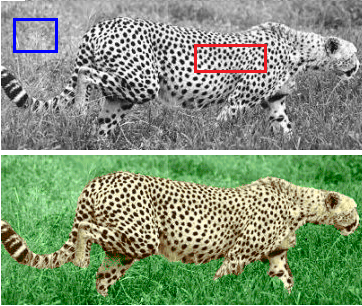
Colorization by Multidimensional Projection
W. Casaca, E. Gomes-Nieto, C. Ferreira, G. Tavares, P. Pagliosa, F.V. Paulovich, L.G. Nonato, and A. Paiva
Proceedings of SIBGRAPI 2012, IEEE Press, 2012, 32-38
Abstract Most image colorization techniques assign colors to grayscale images by embedding image pixels into a highdimensional feature space and applying a color pattern to each cluster of high-dimensional data. A main drawback of such an approach is that, depending on texture patterns and image complexity, clusters of similar pixels can hardly be defined automatically, rendering existing methods prone to fail. In this work we present a novel approach to colorize grayscale images that allows for user intervention. Our methodology makes use of multidimensional projection to map high-dimensional data to a visual space. User can manipulate projected data in the visual space so as to further improve clusters and thus the colorization result. Different from other methods, our interactive tool is ease of use while still being flexible enough to enable local color modification. We show the effectiveness of our approach through a set of examples and comparisons against existing colorization methods.